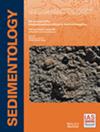云南东部凡湖北部陆架微生物岩:形态、结构、稳定同位素地球化学和年龄
IF 2.8
2区 地球科学
Q1 GEOLOGY
引用次数: 0
摘要
凡湖是世界上最大的碱性湖泊,拥有一些世界上最大的微生物塔,它们被认为是古代叠层石的现代类似物。本研究探讨了微生物岩演化与地质、气候和水文之间的联系,以及生物和非生物过程在微生物岩生长和形态中的作用。为此,通过海底地震剖面和潜水对凡湖北部陆架进行了调查,并在水深25 m处采集了两个9 m和15 m高的微生物岩烟囱。对样品进行了稳定氧和碳同位素分析、X射线衍射、扫描电子显微镜和U/Th年龄测定。凡湖的微生物岩沉淀在聚集的富含钙的地下水流入湖底与碱性湖水混合的地方。微生物岩的柱状、圆锥状和分枝状形态的变化表明了地下水在烟囱内形成的不同过程。总的来说,我们的数据表明,微生物烟囱是在过去一千年内形成的,最有可能是在温暖湿润的中世纪气候异常时期(大约公元800-1300年),当时由于河流富含钙的淡水和地下水的输入增加,湖泊水位上升到现在的水平。我们新的扫描电镜观察表明,在蓝藻覆盖的外壳下,微生物岩的内部结构是由钙化细丝、球状聚集体和藻类、蓝藻和异菌起源的纳米晶体以及无机沉淀的棱柱状方解石晶体构成的。这些结构特征以及潜水观测清楚地表明,在微生物烟囱的快速生长过程中,地下水排放点的无机碳酸盐沉淀,其次是蓝藻和藻类粘液沉积以及光区微生物介导的钙化作用。考虑到叠层石的某些结构与古代叠层石和陨石的结构非常相似,本研究结果为叠层石形成和地外生命演化的环境条件提供了新的见解。本文章由计算机程序翻译,如有差异,请以英文原文为准。
Microbialites on the northern shelf of Lake Van, eastern Türkiye: Morphology, texture, stable isotope geochemistry and age
ABSTRACT Lake Van, the world's largest alkaline lake, hosts some of the largest microbialite towers worldwide, which are considered as modern analogues of ancient stromatolites. This study investigates the links between microbialite evolution, geology, climate and hydrology, and the role of biotic and abiotic processes in microbialite growth and morphology. For these objectives, the northern shelf of Lake Van was surveyed by subbottom seismic profiling and diving, and two 9 m and 15 m high microbialite chimneys were sampled at 25 m water depth. Samples were analysed for stable oxygen and carbon isotopes, X‐ray diffractometry, scanning electron microscopy and U/Th age dating. Lake Van microbialites precipitate wherever focused Ca‐rich groundwater flows to the lake floor to mix with alkaline lake water. Variable columnar, conical and branching morphologies of the microbialites indicate various processes of formation by groundwater channelling within the chimneys. Collectively, our data suggest that the microbialite chimneys have formed within the last millennium, most likely during the warm and humid Medieval Climate Anomaly ( ca AD 800–1300), when lake level rose approximately to the present level due to enhanced Inputs of riverine Ca‐rich freshwater and groundwater. Our new scanning electron microscopy observations indicate that the internal structure of the microbialites below the outer cyanobacteria‐covered crust is constructed by calcified filaments, globular aggregates and nanocrystals of algal, cyanobacterial and heterobacterial origins and inorganically precipitated prismatic calcite crystals. These textural features, together with dive observations, clearly demonstrate the important role of inorganic carbonate precipitation at sites of groundwater discharge, followed by cyanobacteria and algal mucilage deposition and microbially meditated calcification in the photic zone in the rapid growth of the microbialite chimneys. Considering the close similarities of some textures with those of ancient stromatolites and meteorites, the results of this study provide new insights into the environmental conditions associated with stromatolite formation and extra‐terrestrial life evolution.
求助全文
通过发布文献求助,成功后即可免费获取论文全文。
去求助
来源期刊

Sedimentology
地学-地质学
CiteScore
8.20
自引率
11.40%
发文量
94
审稿时长
6-12 weeks
期刊介绍:
The international leader in its field, Sedimentology publishes ground-breaking research from across the spectrum of sedimentology, sedimentary geology and sedimentary geochemistry.
Areas covered include: experimental and theoretical grain transport; sediment fluxes; modern and ancient sedimentary environments; sequence stratigraphy sediment-organism interaction; palaeosoils; diagenesis; stable isotope geochemistry; environmental sedimentology
 求助内容:
求助内容: 应助结果提醒方式:
应助结果提醒方式:


